Abstract
OBJECTIVE: To assess the extent of early atherosclerotic changes of the carotid arteries in young patients with familial hypercholesterolaemia (FH) detected as increased intima-media thickness (IMT), and to determine the relations between IMT and some clinical and blood variables such as lipid and lipoprotein(a) (Lp(a)) concentration and haemostatic factors. DESIGN: The IMT of the carotid bifurcation, the proximal 1 cm of the internal carotid artery, and the distal 1 cm of the common carotid artery was determined in all subjects using B mode ultrasonography. Blood lipids, fasting glucose, and several haemostatic variables were also analysed. SUBJECTS: 28 patients with FH (12 males and 16 females aged 11 to 27 years, one homozygote, 27 heterozygotes) and 28 sex and age matched normolipidaemic healthy subjects. RESULTS: The mean carotid IMT (the average of six measurements of the maximum far wall IMT in the three carotid segments on each side) was significantly greater in patients with FH than in controls (mean (SD) 0.71 (0.15) v 0.49 (0.08) mm, P < 0.001). In all subjects, the mean IMT was significantly correlated with total cholesterol (r = 0.59), low density lipoprotein (LDL) cholesterol (r = 0.60), triglycerides (r = 0.27), and systolic blood pressure (r = 0.47). No correlation was found between the mean IMT and Lp(a), fibrinogen, tissue plasminogen activator, and plasminogen activator inhibitor 1. CONCLUSIONS: The majority of young patients with FH have a greater intima-media thickness of the carotid arteries than healthy subjects. Since the individual susceptibility of patients with FH to increased LDL cholesterol is different, B mode ultrasonography could provide a useful tool to identify those who are more likely to develop premature atherosclerotic disease.
Full text
PDF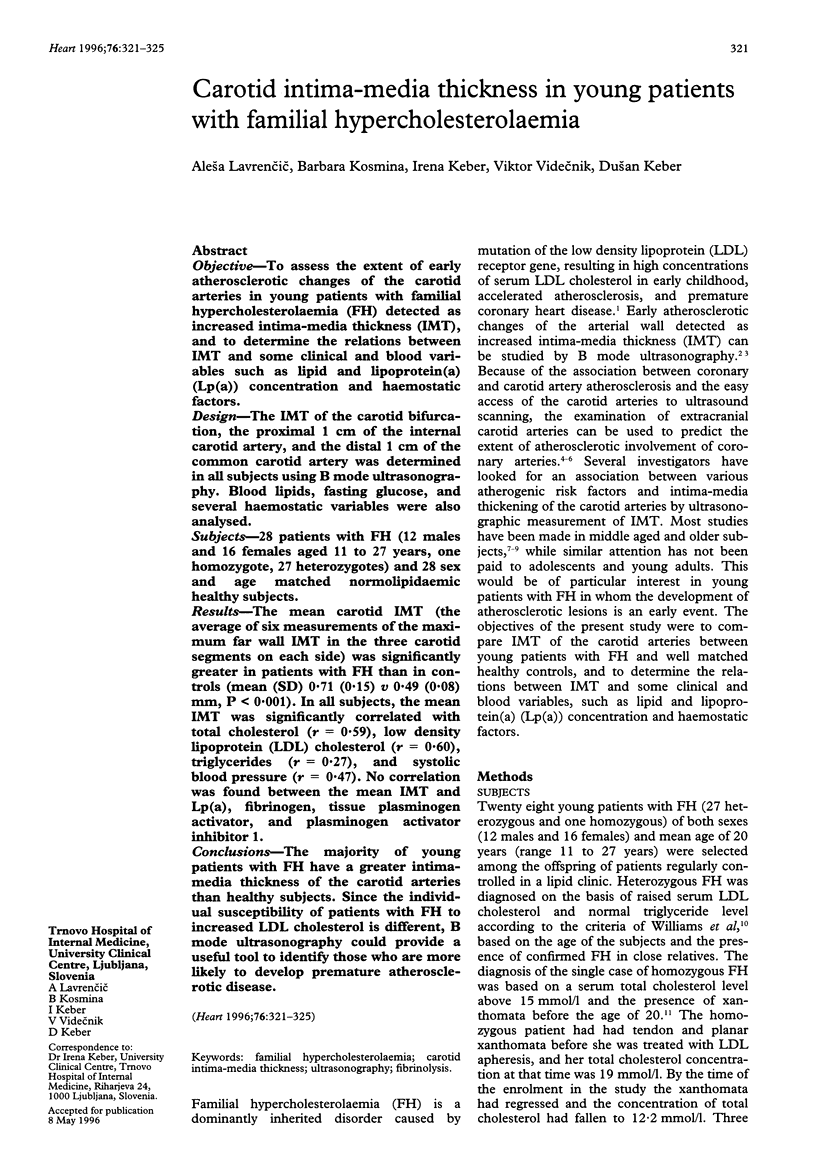
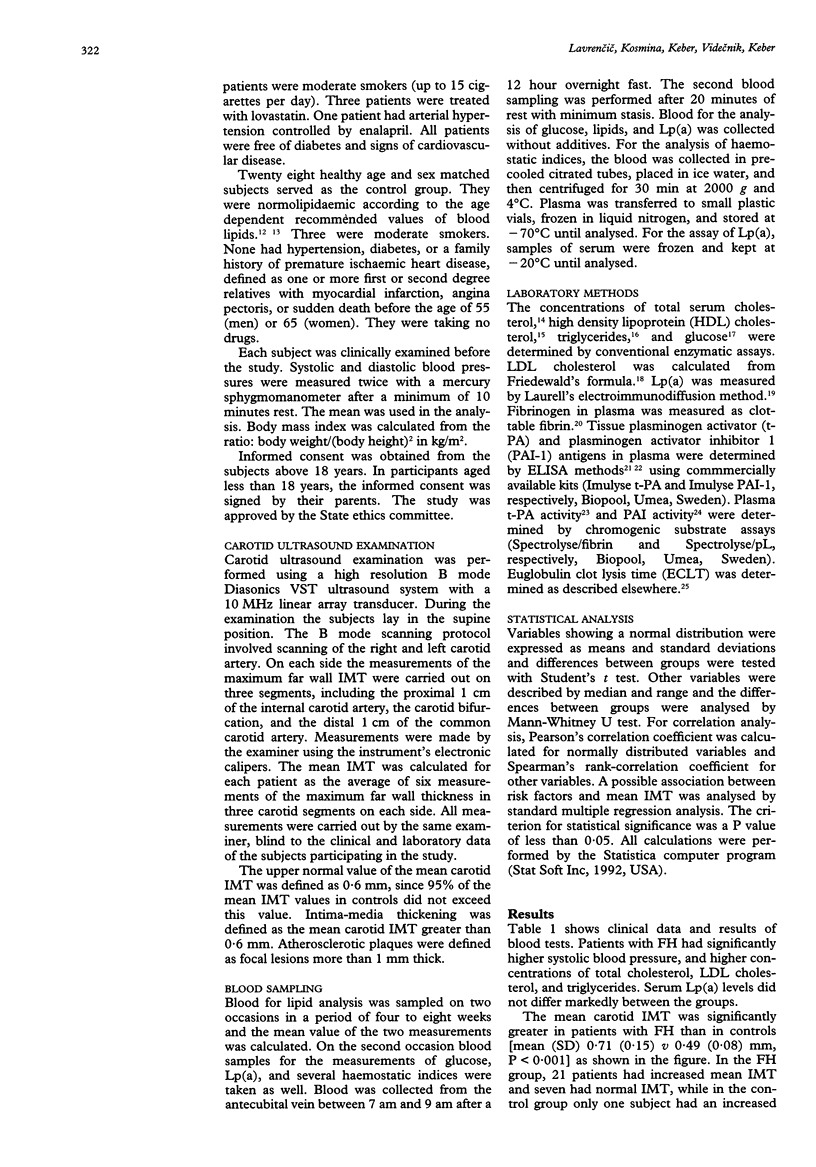
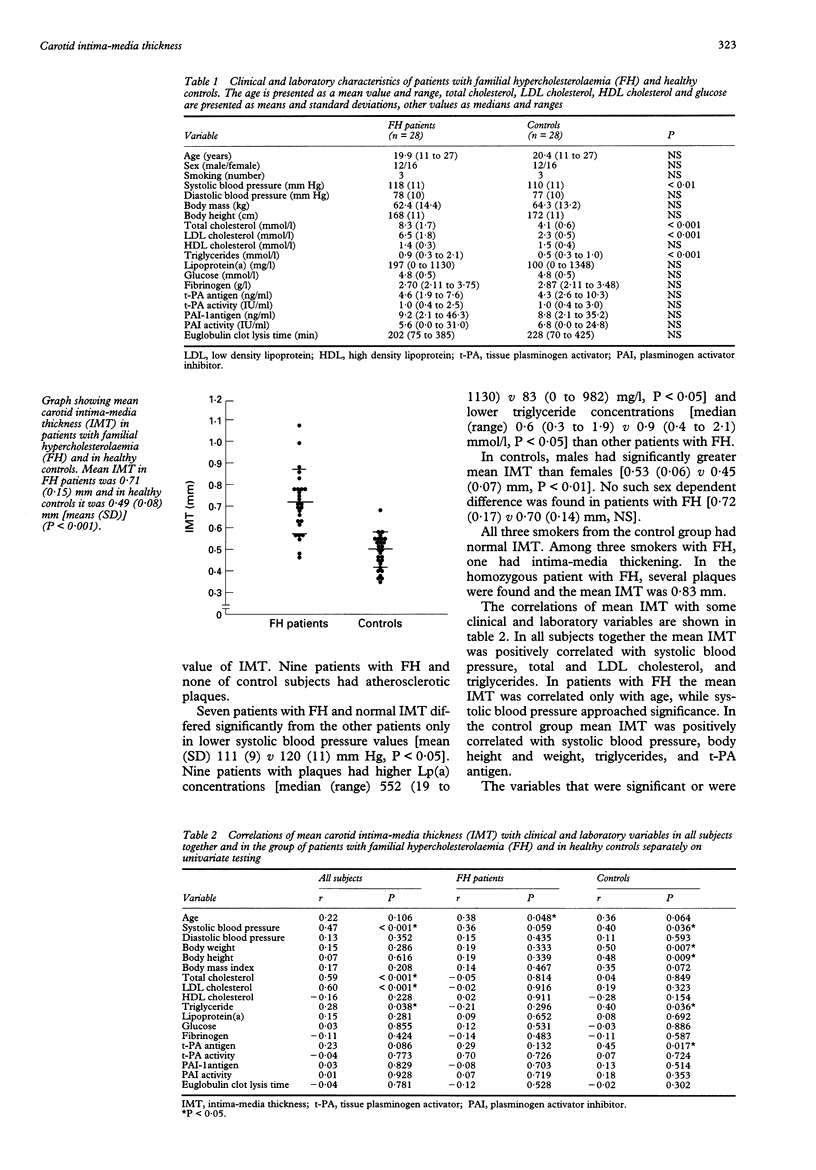
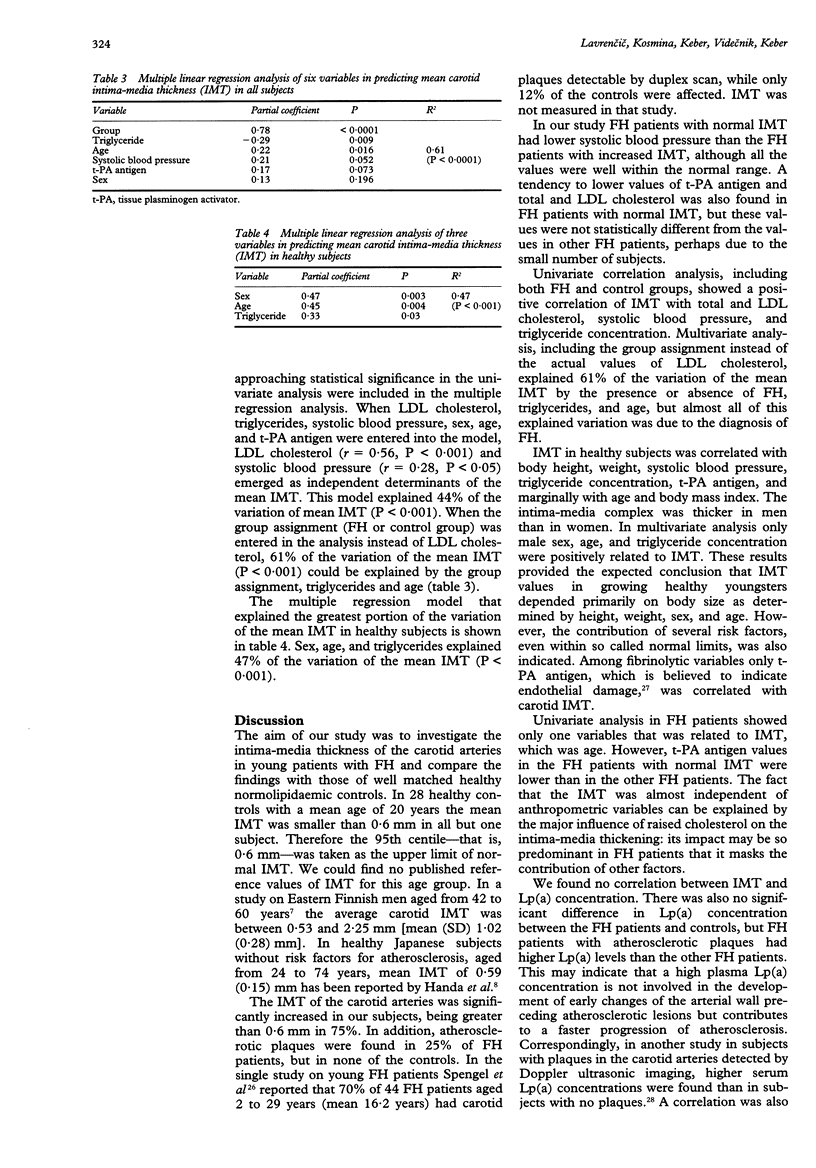
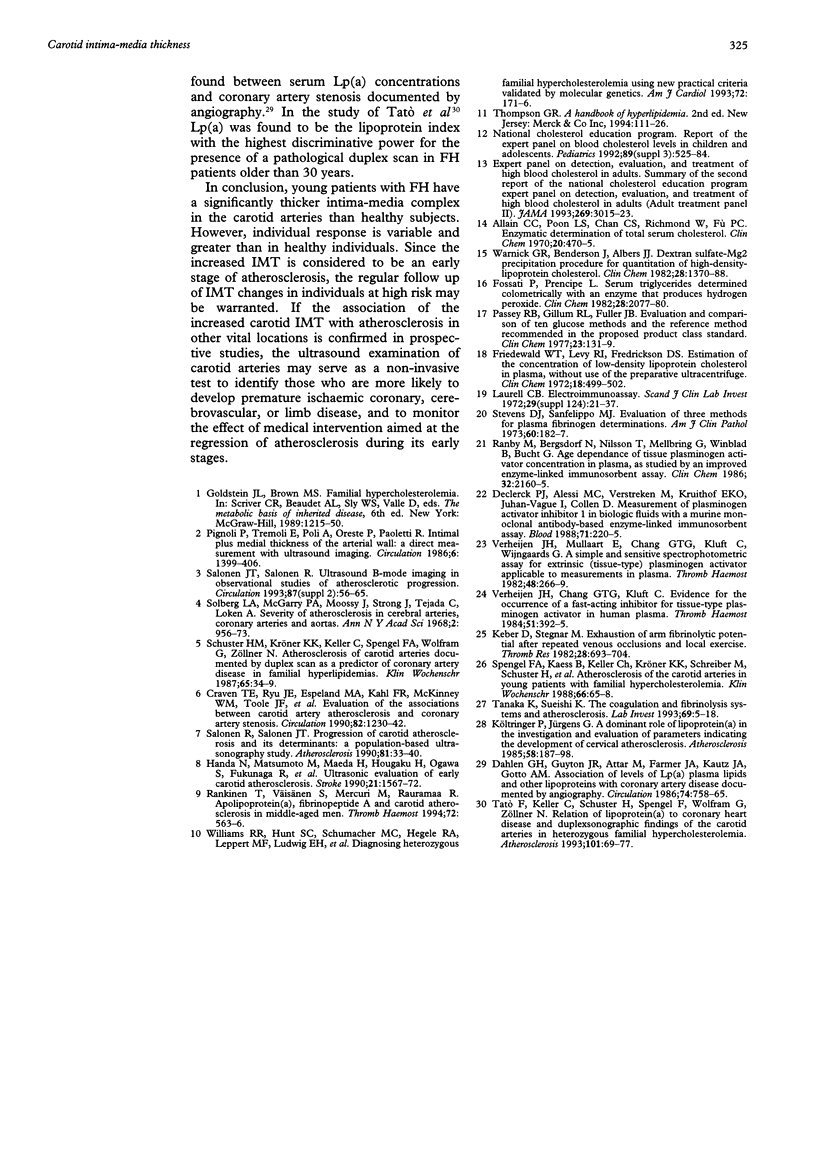
Selected References
These references are in PubMed. This may not be the complete list of references from this article.
- Allain C. C., Poon L. S., Chan C. S., Richmond W., Fu P. C. Enzymatic determination of total serum cholesterol. Clin Chem. 1974 Apr;20(4):470–475. [PubMed] [Google Scholar]
- Craven T. E., Ryu J. E., Espeland M. A., Kahl F. R., McKinney W. M., Toole J. F., McMahan M. R., Thompson C. J., Heiss G., Crouse J. R., 3rd Evaluation of the associations between carotid artery atherosclerosis and coronary artery stenosis. A case-control study. Circulation. 1990 Oct;82(4):1230–1242. doi: 10.1161/01.cir.82.4.1230. [DOI] [PubMed] [Google Scholar]
- Dahlen G. H., Guyton J. R., Attar M., Farmer J. A., Kautz J. A., Gotto A. M., Jr Association of levels of lipoprotein Lp(a), plasma lipids, and other lipoproteins with coronary artery disease documented by angiography. Circulation. 1986 Oct;74(4):758–765. doi: 10.1161/01.cir.74.4.758. [DOI] [PubMed] [Google Scholar]
- Declerck P. J., Alessi M. C., Verstreken M., Kruithof E. K., Juhan-Vague I., Collen D. Measurement of plasminogen activator inhibitor 1 in biologic fluids with a murine monoclonal antibody-based enzyme-linked immunosorbent assay. Blood. 1988 Jan;71(1):220–225. [PubMed] [Google Scholar]
- Fossati P., Prencipe L. Serum triglycerides determined colorimetrically with an enzyme that produces hydrogen peroxide. Clin Chem. 1982 Oct;28(10):2077–2080. [PubMed] [Google Scholar]
- Friedewald W. T., Levy R. I., Fredrickson D. S. Estimation of the concentration of low-density lipoprotein cholesterol in plasma, without use of the preparative ultracentrifuge. Clin Chem. 1972 Jun;18(6):499–502. [PubMed] [Google Scholar]
- Handa N., Matsumoto M., Maeda H., Hougaku H., Ogawa S., Fukunaga R., Yoneda S., Kimura K., Kamada T. Ultrasonic evaluation of early carotid atherosclerosis. Stroke. 1990 Nov;21(11):1567–1572. doi: 10.1161/01.str.21.11.1567. [DOI] [PubMed] [Google Scholar]
- Keber D., Stegnar M. Exhaustion of arm fibrinolytic potential after repeated venous occlusions and local exercise. Thromb Res. 1982 Dec 15;28(6):693–704. doi: 10.1016/0049-3848(82)90094-9. [DOI] [PubMed] [Google Scholar]
- Költringer P., Jürgens G. A dominant role of lipoprotein(a) in the investigation and evaluation of parameters indicating the development of cervical atherosclerosis. Atherosclerosis. 1985 Dec;58(1-3):187–198. doi: 10.1016/0021-9150(85)90065-6. [DOI] [PubMed] [Google Scholar]
- Laurell C. B. Electroimmuno assay. Scand J Clin Lab Invest Suppl. 1972;124:21–37. doi: 10.3109/00365517209102748. [DOI] [PubMed] [Google Scholar]
- Passey R. B., Gillum R. L., Fuller J. B., Urry F. M., Giles M. L. Evaluation and comparison of 10 glucose methods and the reference method recommended in the proposed product class standard (1974). Clin Chem. 1977 Jan;23(1):131–139. [PubMed] [Google Scholar]
- Pignoli P., Tremoli E., Poli A., Oreste P., Paoletti R. Intimal plus medial thickness of the arterial wall: a direct measurement with ultrasound imaging. Circulation. 1986 Dec;74(6):1399–1406. doi: 10.1161/01.cir.74.6.1399. [DOI] [PubMed] [Google Scholar]
- Rankinen T., Väisänen S., Mercuri M., Rauramaa R. Apolipoprotein(a), fibrinopeptide A and carotid atherosclerosis in middle-aged men. Thromb Haemost. 1994 Oct;72(4):563–566. [PubMed] [Google Scholar]
- Rånby M., Bergsdorf N., Nilsson T., Mellbring G., Winblad B., Bucht G. Age dependence of tissue plasminogen activator concentrations in plasma, as studied by an improved enzyme-linked immunosorbent assay. Clin Chem. 1986 Dec;32(12):2160–2165. [PubMed] [Google Scholar]
- Salonen R., Salonen J. T. Progression of carotid atherosclerosis and its determinants: a population-based ultrasonography study. Atherosclerosis. 1990 Feb;81(1):33–40. doi: 10.1016/0021-9150(90)90056-o. [DOI] [PubMed] [Google Scholar]
- Schuster H. M., Kröner K. K., Keller C., Spengel F. A., Wolfram G., Zöllner N. Atherosclerosis of the carotid arteries documented by duplex scan as a predictor of coronary artery disease in familial hyperlipidemias. Klin Wochenschr. 1987 Jan 5;65(1):34–39. doi: 10.1007/BF01785526. [DOI] [PubMed] [Google Scholar]
- Sollberg L. A., McGarry P. A., Moossy J., Strong J. P., Tejada C., Löken A. C. Severity of atherosclerosis in cerebral arteries, coronary arteries, and aortas. Ann N Y Acad Sci. 1968 Nov 21;149(2):956–973. doi: 10.1111/j.1749-6632.1968.tb53849.x. [DOI] [PubMed] [Google Scholar]
- Spengel F. A., Kaess B., Keller C., Kröner K. K., Schreiber M., Schuster H., Zöllner N. Atherosclerosis of the carotid arteries in young patients with familial hypercholesterolemia. Klin Wochenschr. 1988 Jan 15;66(2):65–68. doi: 10.1007/BF01713013. [DOI] [PubMed] [Google Scholar]
- Stevens D. J., Sanfelippo M. J. Evaluation of three methods for plasma fibrinogen determination. Am J Clin Pathol. 1973 Aug;60(2):182–187. doi: 10.1093/ajcp/60.2.182. [DOI] [PubMed] [Google Scholar]
- Tanaka K., Sueishi K. The coagulation and fibrinolysis systems and atherosclerosis. Lab Invest. 1993 Jul;69(1):5–18. [PubMed] [Google Scholar]
- Tatò F., Keller C., Schuster H., Spengel F., Wolfram G., Zöllner N. Relation of lipoprotein(a) to coronary heart disease and duplexsonographic findings of the carotid arteries in heterozygous familial hypercholesterolemia. Atherosclerosis. 1993 Jun;101(1):69–77. doi: 10.1016/0021-9150(93)90103-2. [DOI] [PubMed] [Google Scholar]
- Verheijen J. H., Chang G. T., Kluft C. Evidence for the occurrence of a fast-acting inhibitor for tissue-type plasminogen activator in human plasma. Thromb Haemost. 1984 Jul 29;51(3):392–395. [PubMed] [Google Scholar]
- Verheijen J. H., Mullaart E., Chang G. T., Kluft C., Wijngaards G. A simple, sensitive spectrophotometric assay for extrinsic (tissue-type) plasminogen activator applicable to measurements in plasma. Thromb Haemost. 1982 Dec 27;48(3):266–269. [PubMed] [Google Scholar]
- Williams R. R., Hunt S. C., Schumacher M. C., Hegele R. A., Leppert M. F., Ludwig E. H., Hopkins P. N. Diagnosing heterozygous familial hypercholesterolemia using new practical criteria validated by molecular genetics. Am J Cardiol. 1993 Jul 15;72(2):171–176. doi: 10.1016/0002-9149(93)90155-6. [DOI] [PubMed] [Google Scholar]
- Woo J., Longley M. A., Cannon D. C. Homogeneous enzyme immunoassay for tobramycin evaluated and compared with a radioimmunoassay. Clin Chem. 1982 Jun;28(6):1370–1374. [PubMed] [Google Scholar]


